|
|
|
Sort Order |
|
|
|
Items / Page
|
|
|
|
|
|
|
| Srl | Item |
| 1 |
ID:
143302
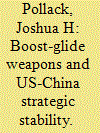

|
|
|
|
|
| Summary/Abstract |
The United States and China are testing boost-glide weapons, long-range strike systems capable of flying at Mach 5 or faster through the upper atmosphere. For the United States, these systems would provide a conventional prompt global strike capability, which, together with US ballistic missile defense programs, Chinese experts regard as a threat to China's ability to conduct nuclear retaliation. This perception is encouraging the Chinese military to modify its nuclear posture in ways that tend to create greater risks for both sides. If China's own boost-glide systems are meant to carry nuclear payloads only, their deployment would not fundamentally alter the current situation between the two states. However, if they were conventionally armed or dual-purpose, or if the United States could not determine the payloads they carried, the deployment of Chinese boost-glide systems could compound problems of strategic stability created by the introduction of ballistic missile defense, antisatellite, and antiship ballistic missile capabilities. If the technical hurdles can be overcome, it may be difficult for the two sides to refrain from these deployments in the absence of strong mutual trust or an established arms-control relationship. New confidence-building measures and expanded mutual transparency are warranted to avoid creating new dangers.
|
|
|
|
|
|
|
|
|
|
|
|
|
|
|
|
| 2 |
ID:
182636
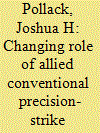

|
|
|
|
|
| Summary/Abstract |
Multiple non-nuclear-armed states in alliances with nuclear-armed states are in the process of acquiring long-range, conventionally armed precision-strike weapons, some of which have potential to contribute to attacks on enemy nuclear forces. This change in the distribution of advanced military technologies has the unintended consequence of giving these non-nuclear-armed states an active role in strategic stability. We provide a theoretical framework for understanding the newly emerging pathways to nuclear use that result. We also investigate perceptions of the role of precision-strike capabilities in six non-nuclear-armed states at various stages in the process of developing these capabilities.
|
|
|
|
|
|
|
|
|
|
|
|
|
|
|
|
| 3 |
ID:
147673
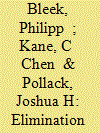

|
|
|
|
|
| Summary/Abstract |
This special issue of the Nonproliferation Review results from a project funded by the US Defense Threat Reduction Agency, aiming to identify lessons learned from efforts to eliminate weapons of mass destruction (WMD) around the world. It contains edited versions of papers presented at a November 2015 workshop at the Washington, DC, offices of the James Martin Center for Nonproliferation Studies. One section covers cross-cutting themes, including the strategic, diplomatic, legal, technical, and inter- and intra-agency dimensions of elimination. The second section discusses lessons learned from work in the former Soviet states, Iraq in the 1990s, Iraq in 2003–04, South Africa, Libya, and Syria. Major observations include that the field lacks institutionalization. There are few standing bodies with funding and responsibility for WMD elimination; each case usually emerges by surprise and has ad hoc character. Different combinations of states and international agencies may be involved, bringing varied authorities and competencies to different operational environments. A generic “checklist” approach accordingly may be best suited to applying past lessons to new missions.
|
|
|
|
|
|
|
|
|
|
|
|
|
|
|
|
| 4 |
ID:
182635
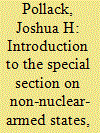

|
|
|
|
|
| Summary/Abstract |
The centerpiece of this issue is a collection of articles resulting from a project undertaken by research staff members of the Royal United Services Institute (RUSI) and the James Martin Center for Nonproliferation Studies (CNS) with the support of the Carnegie Corporation of New York. This study explores the consequences of the proliferation of long-range conventional precision-strike technology to certain countries—namely, those that do not possess nuclear weapons but have one or more nuclear-armed allies or partners and one or more nuclear-armed would-be adversaries.
|
|
|
|
|
|
|
|
|
|
|
|
|
|
|
|
| 5 |
ID:
167787
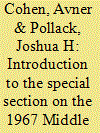

|
|
|
|
|
| Summary/Abstract |
Public understanding of the nuclear dimensions of the June 1967 Middle East War has progressed considerably since the late 1990s. Then, Israeli researchers showed that the vulnerability of Israel’s nuclear facility at Dimona to Egyptian air power played a significant role in the thinking of Israel’s military and political leaders during the crisis of May and early June. This issue’s special section offers significant new advances in addressing unresolved questions about the role of Israel’s nuclear program during these events. Did Egypt’s leaders actually have designs on Dimona, and how did their thinking about Dimona change over the course of the crisis? How close was Israel to possessing a usable nuclear device on the war’s eve? In what manner and circumstances might Israel have detonated its nuclear device? Did the US government know or suspect that Israel had an underground reprocessing plant adjacent to the Dimona reactor, enabling it to separate plutonium and build nuclear devices?
|
|
|
|
|
|
|
|
|
|
|
|
|
|
|
|
| 6 |
ID:
182640
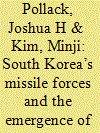

|
|
|
|
|
| Summary/Abstract |
South Korea’s sustained pursuit of conventional precision-strike capabilities and greater autonomy in military decision making is reshaping strategic-stability dynamics between its nuclear-armed ally, the United States, and its nuclear-armed adversary, North Korea. For the last decade, advances in conventional, precision-strike missiles in both Koreas have accompanied reciprocal threats of pre-emption and attacks on leaders, creating a new pathway for a crisis to escalate into a war. Given US security guarantees to South Korea, and North Korea’s development of a nuclear arsenal to deter the United States, any large-scale armed conflict in Korea is liable to involve the use of nuclear weapons. The traditional concern of the alliance with the quality of extended deterrence should be broadened to reflect an understanding of this triangular stability dynamic.
|
|
|
|
|
|
|
|
|
|
|
|
|
|
|
|
|
|
|
|
|